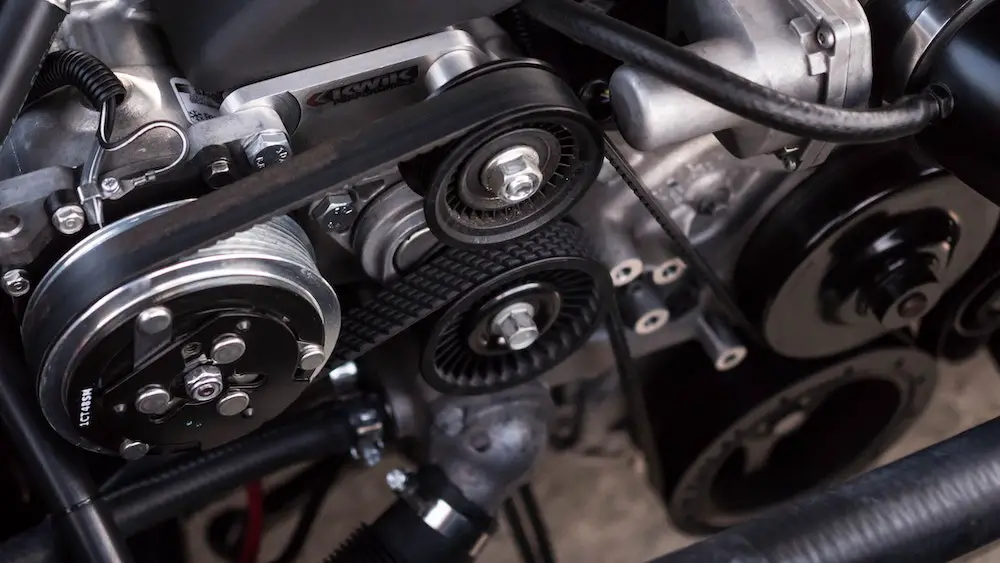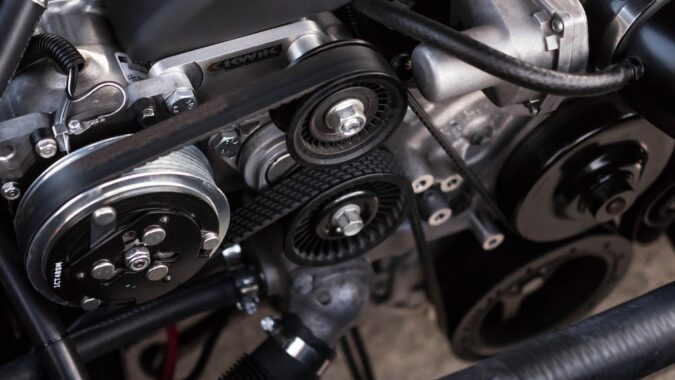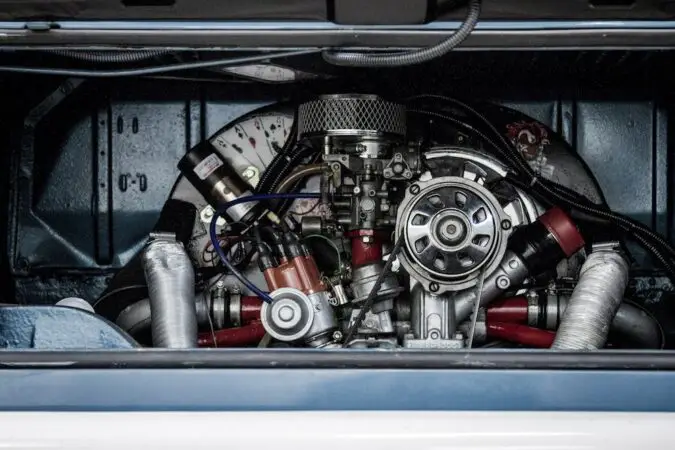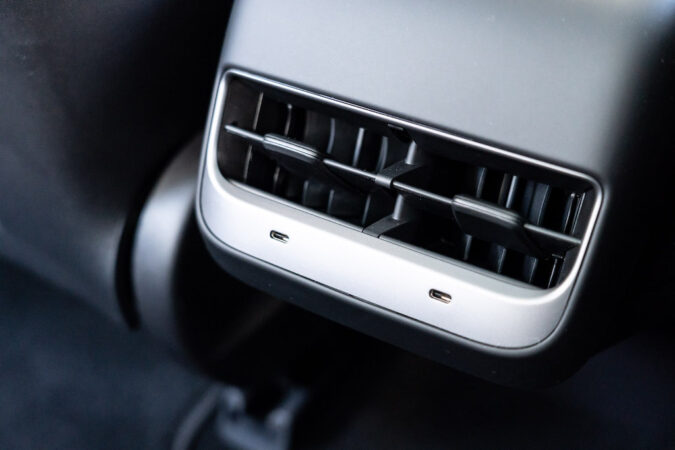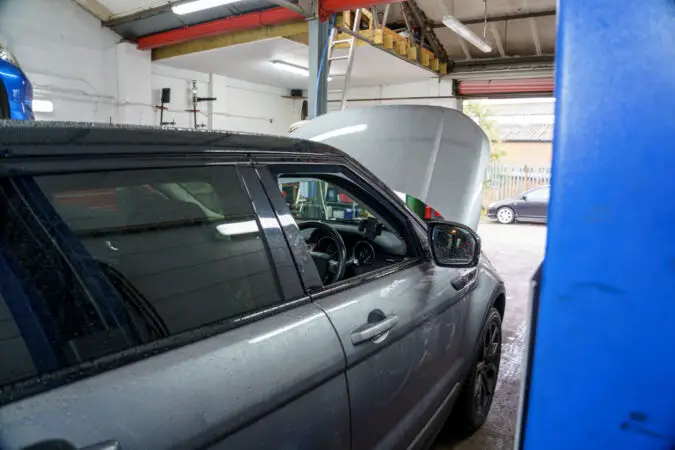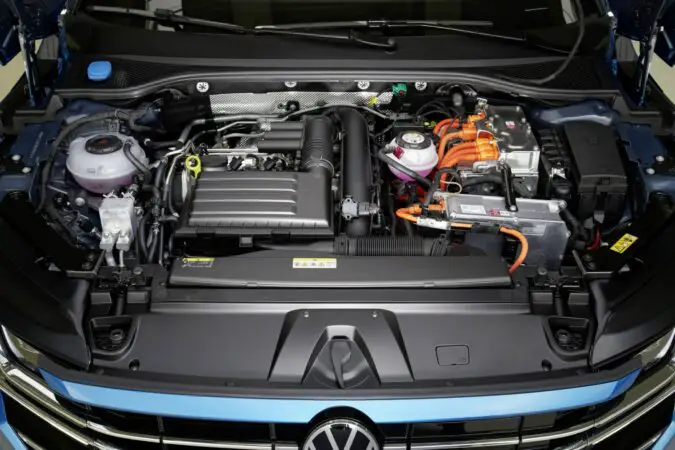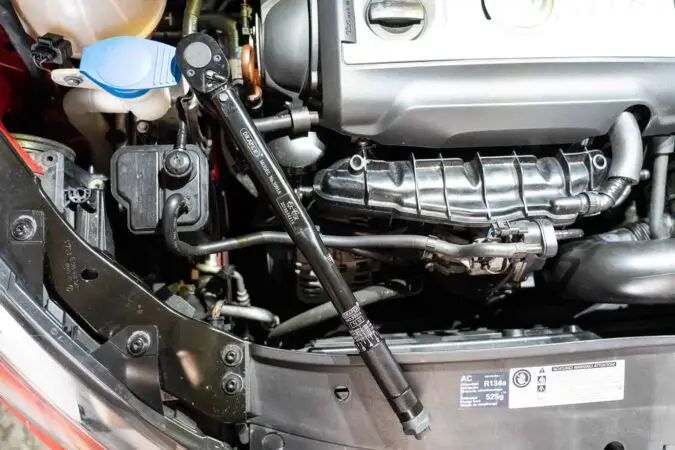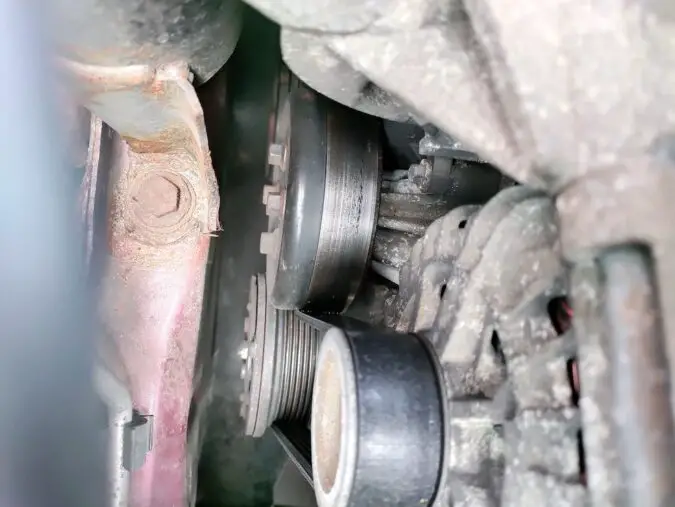Did you know, that a single car is made from over 30,000 components? Granted, this is a very broad generalization, counting down to every single screw, nut, and bolt. Although, we can still estimate that more than 10,000 parts altogether make up the modern automobile. A lot of that sits within your engine bay. As they say, the more pieces you have of a puzzle, the more likely it is to go wrong. Hence why every so often, you’ll need to worry about things such as a serpentine belt replacement cost.
While a rubbery loop might not sound all too important, the serpentine belt is among the most vital bits that make an engine tick and tock. Without the serpentine belt in place, your car may not have functioned as well as it does.
Where else are all your modern amenities and creature comforts going to get power from? But as with many things in life, your car’s serpentine belt doesn’t last until the end of time and has its own shelf life. So, how much is a serpentine belt replacement cost, anyway?
- What Is It?
- Serpentine Belt v. Timing Belt
- Why Wear Out?
- Symptoms
- Costs
- DIY v. Workshop
- Conclusion
- FAQs
Serpentine Belt
Sometimes referred to as the ‘drive belt‘, the ‘serpentine belt’ is a rubberized band that sits within your engine. More specifically, it’s usually placed along the front of the engine, sandwiched between the motor and radiator.
As we hinted at the start of our guide on serpentine belt replacement cost, its main task is transmitting a bit of the engine power to energize other parts of the car. It includes the power steering pump, alternator, air conditioning compressor, oil pump, and water pump.
This is what makes the serpentine belt such a valuable asset for your car’s many functions. It’s from here where it gets its name, as the belt serpentines and wraps around the various aforementioned accessories.
Being a V-ribbed belt, there are ribs along the inner surface of the belt. It can then come into contact with the grooves of the drive pulleys for those accessories, like the alternator and so on. The opposing side of the belt is flat, and contacts with the tensioner roller to keep it in place.
Compared to a conventional drive belt, modern serpentine belts are a lot thinner. Thus, it bends a lot easier to weave in and out of pulleys. Owing to its importance in the workings of your car, the serpentine belt needs to be robust.
As such, it’s made from a very durable rubber compound. Some cars today even have two serpentine belts depending on the size and function of the vehicle. Serpentine belts, compared to older drive belts, also lasts longer and are easier to install, remove, or replace.
Serpentine Belt Vs Timing Belt
There’s a common misconception that we should first try and clear before getting too far into our guide on serpentine belt replacement cost. Many people interchangeably confuse your engine’s timing belt, with the serpentine (or drive) belt.
Mind you, these are two very different rubber bands, with very distinct functions at play. Yet, both are crucial components in any vehicle. As we learned so far, the serpentine belt is made to power other accessories of your car by directing energy from the engine.
The timing belt, meanwhile, is actually for the engine itself, connecting the camshaft and crankshaft together. As the name suggests, the timing belt’s primary role, as its name suggests, is timing the combustion process.
It enables the camshaft up top to open and close the intake and exhaust valves, respectively. As it does this, it synchronizes the movement of the pistons along the crankshaft at the bottom. In the end, the timing belt ensures that the piston doesn’t collide with the engine’s valve train.
Therefore, the timing belt is made from equally strong materials, like urethane, neoprene, or molded polyurethane. It appears somewhat similar to the serpentine belt but is a bit thicker. The teeth of the timing belt are made from rubber.
In some cars, rather than use a rubberized timing belt, they instead adopt a metal timing chain. The consequences of a bad timing belt, suffice to say, is far more serious to the engine. Compared to a failing serpentine belt, the timing belt could cause engine failure.
How Long Do Serpentine Belts Last
Now that we’ve understood the differences between the timing and serpentine belt, we should head to another conundrum. If the serpentine belt is such an important part of the engine, how can it wear out? The lifespan of a serpentine belt varies.
Older drive belts may last at least 45,000 miles. Though on average, most serpentine belts will last for around 60,000 miles, or upwards of 100,000 miles if you take good care of them. As a whole, it ought to be replaced every three to five years.
Over time, they can wear out and break with age. These could be attributed to any number of causes on top of which could wear the serpentine belt prematurely. It includes exposure of the belt to oil or coolant leaks.
Contaminants and debris can also start eating away at the belt. The tensioner roller might displace the incorrect amount of tension, causing the belt to become misaligned. Elsewhere, even the bearings on the drive pulleys, should they fail, might put a lot of strain on the serpentine belt. But the real risk is the belt snaps.
Bad Serpentine Belt Symptoms
When the serpentine belts do fail – as we’ll get into in our serpentine belt replacement cost overview – they can show off all sorts of symptoms. Once you’ve experienced them first-hand, it’s a good idea to have your serpentine belt checked up and replaced as soon as possible.
The consequence of not doing so promptly could be deadly. Otherwise, it might cause a lot of discomfort and inconveniences to you, not to mention putting a lot of stress on other parts of the car.
That latter point will surely make what is (spoilers) a fairly affordable repair into a catastrophically expensive one. You should never ignore a bad or failing serpentine belt. So, here’s a checklist of tell-tale signs of worn, faulty, or completely snapped serpentine belts that you should be on the lookout for…
Symptoms #1: Odd Squealing Noise
The most common symptom that you’ll encounter for serpentine belt failure happens by sound. A worn-out belt can emit unusual and high-pitched sounds. You’ll hear these squealing, squeaking, screeching, or chirping noises as soon as you start your car up.
If this is the case, it’s often caused by your belt being misaligned. Or, it’s slipped from the pulleys. You could then have this realigned or re-tensioned to fix the issue. Other times, however, it may require a replacement.
Symptoms #2: Engine Overheating
As we noted earlier, a failing serpentine belt would result in the accessories that are reliant on it for power will stop working. Among the first that you’d notice is the engine overheating. The serpentine belt is what drives the water pump.
This would then circulate coolant around the engine, and back to the radiator. Without a working serpentine belt, the water pump will otherwise remain idle. At this point, your engine will start heating up, as it isn’t able to receive any cooling whatsoever.
Symptoms #3: No Power Steering
If you’ve somehow missed your engine heating up, then you’ll certainly notice this. Remember that the serpentine belt is also responsible for the power steering pump. This pump manages the flow of hydraulic power steering fluid.
Thanks to this pressurized liquid, power steering enables you to turn the wheel effortlessly. But when the serpentine belt does fail, the steering wheel stiffens. You’ll find that even a simple turn is difficult. It becomes more dangerous knowing that you’re on the move.
Symptoms #4: No Air-Conditioning
This is a bit less serious than the previous tell-tale sign, but one that is no doubt discomforting. Your car’s A/C compressor is among those components that are connected to the serpentine belt to have power.
So, if the serpentine belt is worn out or has broken off, then the air-conditioning won’t be able to work. If you turn on your car’s air-conditioning system and find that it doesn’t blow out any cold air, then it’s time that you check your serpentine belt.
Symptoms #5: Dead Battery – Unable To Start or Drive
One more component within your car that needs the serpentine belt to provide it with power is the alternator. This is what converts the mechanical energy of your car’s engine, and transforms it into usable electric charge to top up the battery.
Note, you can happily drive along for some distance, as the battery will still likely have some charge left in it. But after a little while, your car will eventually die, as the battery’s remaining electrical supply is completely dried up.
Symptoms #6: Cracks On The Belt
Rather than having to experience any of those symptoms from earlier, you can tell how your belt’s doing without even having to start up the car. The serpentine belt is quite visible in most vehicles, as it sits proudly up front.
As it ages, cracks can appear along the surface of the serpentine belt. Other than that, you might also notice missing chunks, abrasions, a separation of the rubber ribs, uneven rib wear, or damaged ribs. If you see any of this, then it’s a good time to have it replaced.
How Much Does a Is A Serpentine Belt Cost To Replace
Right, it’s a good time to sit down and get to the bottom of how much a serpentine belt cost is. Before you turn away in horror, you should know that having your serpentine belt replaced is actually quite simple and cheap.
This is relative, of course, to other types of automotive maintenance and repair. We mentioned before that newer serpentine belts have evolved quite a bit since the old drive belt designs. The new ones are more durable and are easier to access and replace.
Overall, the average serpentine belt replacement cost for most vehicles is somewhere between $70 to $200. On a common passenger car or crossover, you can expect a ballpark of around $150.
That’s quite a wide margin, and there are a couple of variables that could narrow it down a bit further. For example, you’ll need to see what vehicle you drive. Heavy-duty or higher performant vehicles may need higher-grade serpentine belts. The raw materials and parts, as a result, would be pricier.
You’ll also need to consider how easy (or hard) it will be for mechanics to access the serpentine belt. Generally, our estimations above account for the price of the serpentine belt, which you can find for between $25 to $75.
However, there are belts selling for just $10. The labor, depending on where you are, would round off to about $150. Let’s say that your belt is easy to replace. If so, there won’t need to be a lot of labor involved. This could cut down the labor costs to as little as $50.
Serpentine Belt Replacement Cost Examples
If you’d like to get a more precise quote for your particular car, you’re in luck. There’s a whole heap of sites online, where you can reliably get quotes for a serpentine belt replacement cost for your exact car.
All you need is to input your car’s make and model, or sometimes just a registration plate. You could then get quotes from hundreds, or thousands of different workshops across the country. Try and give sites like YourMechanic, Wrench, RepairSmith, RepairPal, OpenBay, and more a go.
Just you give you a better idea, we’ve found some cost examples of serpentine belt replacement cost for a little comparison. These are among the best-selling vehicles in the US, so it should paint a clearer picture of how lighter your wallet will be after this…
- Ford F-Series – $120 – $160
- Chevrolet Silverado – $110 – $160
- Ford Fusion – $70 – $150
- Ford Focus – $70 – $150
- Honda CR-V – $100 – $130
- Nissan Altima – $100 – $130
- Honda Civic – $100 – $130
- Honda Accord – $100 – $130
- Toyota Camry – $120 – $160
- Toyota Corolla – $120 – $160
How To Replace Serpentine Belt
In the hands of a professional, replacing a serpentine belt can take as little time as just 15 minutes. Harder-to-reach vehicles might take a bit longer, say 30 minutes. Nonetheless, this does prove that this is one repair job that you can in fact do at home.
This would no doubt save you a lot on labor fees for a full serpentine belt replacement cost by doing it by yourself, too. Although, if you’re not confident with your DIY skills, then it’s best to leave this to the professionals.
Otherwise, pay attention. You won’t need any specialty tools for this, either. Even for a novice, it would take just about an hour to complete…
Step 1 – Getting Acquainted With Everything
Before we could begin, there are a few things we should do beforehand. First and foremost, you should disconnect the battery. This is a wise thing to do any time you’re working on your car, on the off chance that you’ll make contact with anything electrical.
Once that’s done, try and find the serpentine belt. While we did say earlier on that the serpentine belt is usually placed up front, that’s not always the case. The belt will be mounted at the front of the engine, not the car itself.
Some cars have transversely mounted engines. This means that the engine is placed sideways. As such, you’ll find that the serpentine belt may be located on one side of the car. If you still can’t find the snaky loop of rubber, you can refer to your owner’s manual.
While you’re there, you need to find out what the belt routing order is. There’s often a diagram in the manual, or sometimes placed in the engine bay as a sticker. It will tell you how the serpentine belt will wrap around the various pulleys.
Step 2 – Loosen The Belt Tensioner
The serpentine belt has a tensioner system, which keeps the belt taut while it’s in use. Depending on your car, it might be a movable tensioner roller, or an automatic tensioner pulley system. Again, you can refer to your owner’s manual to find out what type of tensioner it has in place.
If you’re willing to spend a bit of money, you could make the task of loosening the tensioner a lot easier on yourself. There are specialized belt tool kits that can aid in this process. But even without it, it’s a fairly simple job.
Most tensioners have a hole that could accommodate a half-inch drive ratchet. Alternatively, it might fit a similarly-sized bolt that you can then use a socket to apply pressure to.
Once you’ve found the right size to fit your car, start twisting it to loosen the tensioner. When you’ve done this, you can start to carefully pull the belt away from the pulleys. With some cars, though, you might first have to loosen some bolts along the alternator bracket, which works to apply more tension to the belt.
Step 3 – Inspect The Old Belt (And Surrounding Components)
Don’t just throw aside the old serpentine belt once you have it off. Inspect it closely for any damage that you couldn’t have noticed before. See if there’s any excess wear or disintegration along the edges of the belt and if there’s any separation of the ribs.
If the answer is ‘yes’, then you have an issue with misalignment. Ignoring this could lead to similar issues down the road with your brand new belt, so it vindicates the idea of checking over the old parts before fitting fresh ones in.
All you need is a ruler to see if all the pulleys are aligned properly. Speaking of pulleys, carefully grab hold of them and inspect to see if they’re all in good order. With some pulleys like the tensioner and power steering pulleys, you can give them a spin.
If they spin freely without any noise, then they’re good to go. Take each pulley by the hand, and gently move your hand in and out, and side to side. If they’re in working condition, there shouldn’t be any movement.
Just the slightest noise or movement while you’re checking over each pulley, and it’s time that you consider replacing them. Or else, the misalignment problems might still persist. Worse, the belt itself could fall off while you’re driving.
Since you’re already in there, check if there are any coolant or oil leaks. Then, take a bit of time to clean off all the old grime, oil, and contaminants left behind with the old belt along the pulleys.
Step 4 – Install The New Belt
Now, take the new belt, and carefully route it in and around all the pulleys as before. It’s a flexible band and should be long enough to adequately cover every component pulley.
This is the time when you need to refer back to that belt routing order, and see how it loops around which area. Should there be a lot of loosenesses, then either you’ve purchased too long of a belt, or you’ve routed it wrongly. If all is well here, you can start routing the belt to the tensioner.
Loosen the tensioner, and position the belt over it. With your finger on the belt, slowly release any pressure on the tensioner system until the belt can rest firmly in place over the tensioner. Next, you can start to increase the tension in the serpentine belt.
It may be easier to have someone help you, as they hold the belt while you tighten the tension. Make sure the belt is centered along each pulley, including the tensioner. It’s important to ensure that the belt is adequately taut, as well.
Serpentine Belt Replacement Cost: In Conclusion…
If you’re confident that the belt is installed right, then start up the engine. Let it idle for a minute or two to make sure the belt is working as intended. Put everything back together, and take your car out for a spin.
At this point, you shouldn’t hear or notice any of the symptoms that we’ve noted before. In all, this goes to show that automotive maintenance doesn’t have to be impossibly difficult, or very ruinously expensive. Our guide on serpentine belt replacement cost proves that it’s quite effortless.
You can buy the whole belt for the price of a hearty lunch. Plus, and if you’re keen to save on excess labor costs, you could replace the belt at home. It’s very little trouble (and expense) to give your car the smooth inner workings that it deserves.
You’ll find that after getting it replaced, your car is just that bit peachier to run. Additionally, you’ll feel a lot safer too, knowing that the power steering isn’t just going to disappear under you. This is definitely one repair that’s absolutely worth the price.
FAQs On Serpentine Replacement Costs
If you’re still curious about a serpentine belt replacement cost, our FAQs here might help…
What Is A Serpentine Belt
The serpentine belt is also sometimes referred to as the drive belt. The name comes from how the serpentine belt snakes around the front of the engine, crisscrossing several pulleys, and other gears. Its primary function is to use some of the engine’s power – through the rotation of the crankshaft pulley – and use that to drive other parts of your car. Specifically, these parts include components like the power steering pump, alternator, air conditioning compressor, oil pump, water/coolant pump, and more. Without that serpentine belt, those individual components wouldn’t have been able to easily derive power from the engine. In this instance, as your engine runs, it’ll rotate the serpentine belt, thus providing power to all those mechanical, electrical, and electronic parts of your car.
How To Replace Serpentine Belt
Unlike replacing a timing belt, the serpentine belt is far easier to replace at home, if you need to. The first thing you should do is disconnect your car’s battery, just in case. Once that’s been done, locate the serpentine belt on the front of the engine. Then, find the tensioner pulley and use a wrench to relieve tension on the belt. This will allow you to more easily slide the belt off of the pulleys. With the old serpentine belt removed, route the new one through those pulleys. Be mindful of how the belt had been routed originally, and how it looped or crisscrossed the numerous pulleys. Each engine should have a belt routing diagram that you can refer to. Finally, use the tensioner to apply some tension to the serpentine belt until its properly taut.
What Happens To A Car When The Serpentine Belt Breaks
Unlike when a timing belt or chain snaps, the breaking of the serpentine belt isn’t nearly as serious. In other words, it won’t cause immediate and catastrophic damage to the engine. However, as the serpentine belt is responsible for powering numerous components in your car, having it break will deprive you of these accessories. For example, you’d notice that you no longer have power steering, as the serpentine belt powers the power steering pump. Moreover, your alternator will stop working, as the battery slowly loses charge. In addition, with the water pump no longer working, your hot engine won’t be able to be supplied with fresh, circulating coolant. The AC would also stop working since a car’s AC compressor derives power from the engine through the serpentine belt.
Is Serpentine Belt The Same As Timing Belt
There’s a common misconception that folks make when it comes to the belts in a car. Primarily, they’d interchangeably use serpentine belt and timing belt together. This isn’t correct, as both the serpentine belt and timing belt are two very different components. The timing belt is used to, as its name suggests, manage the timing of the combustion process of your car’s engine. It connects the engine’s camshaft up top with the crankshaft down below. In doing so, that timing belt synchronizes the opening and closing of the intake and exhaust valves (operated by the camshaft) with the upward and downward movement of the pistons (connected to the crankshaft). Meanwhile, the serpentine belt is used to derive some of your engine’s operation to power numerous other components and accessories on your car.
What Causes A Serpentine Belt To Break
Given its importance, a serpentine belt is thus typically made to last a long time. Older drive belts only last around 45,000 miles before you have to consider a serpentine belt replacement cost. Meanwhile, newer serpentine (aka drive) belts could last upwards of 60,000 or even 100,000 miles if you take good care of them. As a rule of thumb, you should replace the serpentine belt once every 3 to 5 years. While drive belts normally die out due to regular wear and tear, several factors could accelerate their lifespan. This includes exposing the drive belt to engine oil or coolant leaks. Otherwise, contaminants and debris collecting on the belt would eat away at the rubber gradually. Faulty tensioners or bearings would also put additional strain on the serpentine belt, causing it to wear prematurely.

